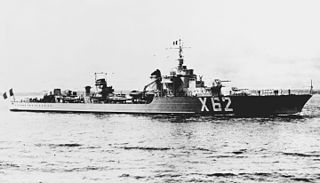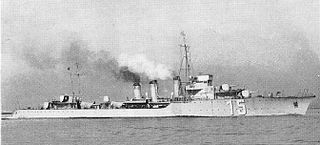
The Chacal-class destroyer, sometimes known as the Jaguar class, were a group of six large destroyers (contre-torpilleurs) built for the French Navy during the 1920s. Their primary role was scouting for the battleline. All were named for predators: Chacal means jackal, and the other five were named for big cats.

The Mogador-class large destroyers (contre-torpilleurs) of the French Navy were laid down in 1935 and commissioned in 1939. They were extremely fast, very large destroyers intended to act as scouts for the two fast Dunkerque-class battleships. The design evolved from the extremely fast Le Fantasque class, being 300 tons heavier and carrying eight guns in semi-enclosed twin turrets rather than five guns in single open mounts. With their eight 138.6 mm (5.46 in) guns they approached a light cruiser in firepower.

The Bourrasque class was a group of twelve French Navy destroyers (torpilleur) laid down in 1923 and in service from 1926 to 1950. Along with the heavier Chacal class, they were part of a plan to modernise the French fleet after the First World War. The Bourrasques were smaller and slower than the Chacals, but were nonetheless comparable with the British W class. The class saw varied service in the Second World War, in five different navies, on both sides. These ships were named after types of wind.
The Le Hardi class consisted of twelve destroyers built for the Marine Nationale during the late 1930s. Only seven ships were ultimately completed while construction of the remaining five ships was interrupted by the French defeat in the Battle of France in May–June 1940 and were never finished. The seven ships that were seaworthy sailed for French North Africa to prevent their capture by the advancing Germans. Several ships later sailed for French West Africa where Le Hardi played a minor role in the Battle of Dakar in September. The Germans captured two ships that were still under construction and attempted to finish them both before abandoning the effort in 1943.

Mogador was the lead ship of the French Navy's Mogador class of destroyers. Named after the Moroccan town, she was built before the outbreak of World War II. The ship was heavily damaged during the British attack on Mers-el-Kébir on 3 July 1940, but was later repaired and sailed to Toulon. She was scuttled in Toulon Harbor when the Germans tried to seize her, along with the rest of the fleet, on 27 November 1942.

Bourrasque was a Bourrasque-class destroyer built for the French Navy during the 1920s.

Siroco was a Bourrasque-class destroyer built for the French Navy during the 1920s.

L'Indomptable was one of six Le Fantasque-class large destroyers built for the Marine Nationale during the 1930s. The ship entered service in 1935 and participated in the Second World War. When war was declared in September 1939, all of the Le Fantasques were assigned to the Force de Raid which was tasked to hunt down German commerce raiders and blockade runners. L'Indomptable made one sortie into the Skaggerak in April 1940 and was then transferred to French Algeria in late April 1940 in case Italy decided to enter the war. She screened French cruisers several times as they unsuccessfully hunted for Italian ships after Italy declared war in June.
Le Hardi was the lead ship of her class of destroyers built for the Marine Nationale during the late 1930s. The ship was completed during the Battle of France in mid-1940 and her first mission was to help escort an incomplete battleship to French Morocco only days before the French signed an armistice with the Germans. She played a minor role in the Battle of Dakar in September, mostly laying smoke screens. Le Hardi helped to escort one of the battleships damaged by the British during their July attack on Mers-el-Kébir, French Algeria, back to France in November. She was reduced to reserve in mid-1942.
The French destroyer Jaguar was a Chacal-class destroyer (contre-torpilleur) built for the French Navy during the 1920s. She spent most of her pre-World War II career as a flagship for various destroyer units. The ship was assigned convoy escort duties in the Atlantic after the start of the World War II in September 1939 until she was badly damaged during a collision in January 1940. Five months later, after her repairs were completed, she was committed to the English Channel after the Battle of France began in May 1940. Jaguar was torpedoed by German E-boats on 23 May and had to beach herself; her wreck was written off as unrepairable.

Tramontane was a Bourrasque-class destroyer built for the French Navy during the 1920s.

Tornade was a Bourrasque-class destroyer built for the French Navy during the 1920s.

Trombe was a Bourrasque-class destroyer built for the French Navy during the 1920s.
Mameluk was one of a dozen Le Hardi-class destroyers built for the French Navy during the late 1930s. The ship was completed during the Battle of France in mid-1940 and her first mission was to help escort an incomplete battleship to French Morocco only days before the French signed an armistice with the Germans in June. She then helped to escort one of the battleships damaged by the British during their July attack on Mers-el-Kébir, French Algeria, back to France in November. Mameluk returned to Morocco in early 1941 for convoy-escort duties and then was transferred back to France in late 1941.
The French destroyer Casque was one of a dozen Le Hardi-class destroyers built for the French Navy during the late 1930s. The ship was completed during the Battle of France in mid-1940 only days before the French signed an armistice with the Germans. When the Germans occupied Vichy France after the Allies landed in French North Africa in November 1942 and tried to seize the French fleet intact, the destroyer was one of the ships scuttled to prevent their capture. The Regia Marina attempted to salvage her in 1943, but the effort was abandoned the following year. The ship was refloated in 1948 and scrapped.
The French destroyer Le Flibustier was one of a dozen Le Hardi-class destroyers built for the French Navy during the late 1930s. Still incomplete when the French signed an armistice to end the Battle of France, material shortages prevented her completion and she was placed in reserve. The ship was renamed Bison in early 1941. When the Germans occupied Vichy France after the Allies landed in French North Africa in November 1942 and tried to seize the French fleet intact, the destroyer was one of the few ships not scuttled to prevent their capture. She was turned over to the Regia Marina in 1943, but was seized by the Germans after the Italian armistice in September. The ship was salvaged in 1945 and later scrapped.
The French destroyer Lansquenet was one of a dozen Le Hardi-class destroyers built for the French Navy during the late 1930s. Placed into service after the French signed an armistice with the Germans in June 1940, she sailed to French Morocco to avoid capture. In November the ship helped to escort one of the battleships damaged by the British during their July attack on Mers-el-Kébir, French Algeria, back to France. Placed in reserve afterwards, she was scuttled to prevent her capture when the Germans occupied Vichy France in November 1942. Lansquenet was salvaged in 1943 by the Regia Marina and captured by the Germans after the Italian armistice in September. They scuttled the ship in Italy in 1945; she was refloated in 1946, but was never repaired. She was stricken in 1958, then scrapped.
Siroco was one of a dozen Le Hardi-class destroyers built for the French Navy during the late 1930s under the name Le Corsaire. Although she was still under construction during the Battle of France, the ship sailed to French Algeria to avoid capture by the Germans. She was renamed Siroco in early 1941 while still under construction and was completed later that year and immediately placed in reserve. The destroyer was one of the ships scuttled to prevent their capture in November 1942 when the Germans occupied Vichy France. Siroco was salvaged by the Regia Marina and towed to Italy in 1943. Captured by the Germans after the Italian armistice in September, the ship was scuttled by the Germans in late 1944 and later scrapped.

The Canon de 37 mm Modèle 1925 was a widely used family of French anti-aircraft guns used by the French Navy during World War II.
The M89 class were a planned series of destroyers for the French Navy. Although initially designed in 1913, the scheduled construction of the two new destroyers was suspended due to the outbreak of World War I before either ship could be laid down. The two destroyers had not yet been given names, being known only by their planned construction numbers, M89 and M90.






